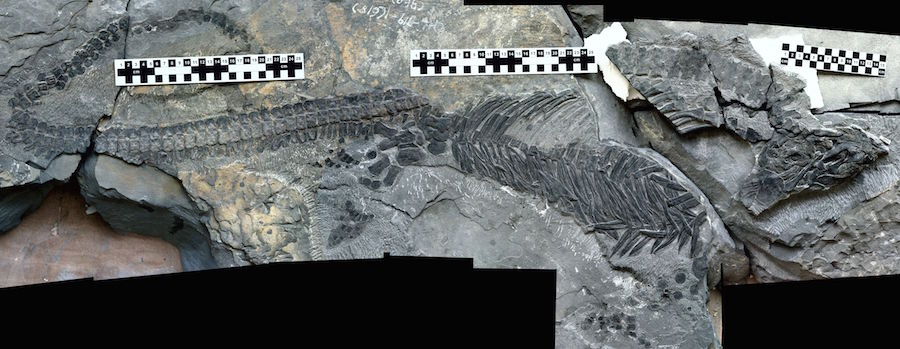
New marine reptile fossil found, questions life at end of Permian period
The Permian mass extinction occurred 250 million years ago and wiped out nearly 96 percent of the planet’s species. However, a recently-discovered marine reptile fossil sheds lights on how quickly life rebounded after the extinction.
The recovered fossil, sclerocormus parviceps, was found in a quarry in Anhui Province, China. Ryosuke Motani, a professor in the UC Davis Department of Earth and Planetary Sciences, along with his colleagues published a paper in Nature Scientific Reports describing the fossil and how this new evidence changes ideas about the evolution of life millions of years ago.
The fossil belongs to a group called ichthyosaurs, a dolphin-like marine reptile that lived in the ocean during the Mesozoic age when dinosaurs walked the Earth.
“What was striking about this animal was that it was large for the time period it came from,” Motani said.“[Though] its head is really small for the body, and we don’t know why this is the case.”
Despite resemblance to dolphins and fish, the sclerocormus parviceps is said to have fed at the sea bottom due to the shape of its snout and would suck in its prey.
Closer relatives would be reptiles such as lizards, snakes and crocodiles because of the ichthyosaurs reptilian skull and fins.
“This animal was very heavily built and its bones are very thick,” Motani said.
Further analysis of the ancient animal determined it was about 5 feet in length, had a short skull and short, stocky body.
In addition, the animal had four fins and a long tail that took up more than half its body length. The animal most likely used its forefins to maneuver itself while swimming.
Over time, it can be observed that the ichythosaurs’ lower arm and finger bones became significantly shorter and eventually the finger became disk-shaped.
According to the fossil record, once ichthyosaurs appeared, they diversified rapidly. Many fossils of different body types have been found, especially from the early and middle Triassic period around 251 to 199 million years ago.
“[The sclerocormus parviceps were] predators […] about the size of humans. To feed this predator in the sea, you have to have enough food,” Motani said. “This means small animals [they consumed] were already there.”
Five major mass extinctions are evident in the fossil record, identified by around 50 percent of species going extinct at one time on a global scale.
“The End-Permian was the largest of these five, it’s estimated somewhere between 90 to 96 percent of the species on earth went extinct,” said Amanda Glynn, a Ph.D. candidate in the Department of Earth and Planetary Sciences.
With the massive end-Permian extinction, there was not only more space on Earth, but more environmental roles that a wider range of organisms could take over.
“You also have, at that time, changes in sea level, which [made] it more favorable for things to go back into the water,” Glynn said.
Scientists have proposed various theories on why the Permian mass extinction occurred. Some of the more popular theories include an asteroid impact, or an intense volcanic eruption that clouded the sky with ash, blocking the sun and polluting the air.
“Different mass extinction events appear to have been caused by different environmental changes,” said Jonathan L. Payne, a Stanford University professor and the chair of Stanford Geological Sciences. “In the case of the end-Permian we have no strong evidence for an asteroid impact, in fact, we have a lot of evidence for volcanic eruptions.”
Other scientists cite evidence for global climate change with sudden rapid heating and cooling, in which organisms would die off because they could not adapt.
A final theory suggests a catastrophic, earthquake-triggered release of methane gas from under the seabed, global warming or an asteroid impact.
There is no solid consensus in the scientific community about which theory or combination of theories proves to be true.
With the conditions of the end-Permian extinction, more organisms made the transition from land to water, resulting in the evolution of these marine reptiles.
Although there was variation among the marine species, there was a general trend of the orgasims evolving from a lizard-shaped body to a fish-shaped body.
The lizard-shaped ichthyosaurs had similar characteristics to living catsharks today, with a more slender backbone and a larger number of vertebrae. The fish-shaped ichthyosaurs had similar characteristics to living great white sharks, consisting of a thick body and backbone and a crescent shaped tail.
More information about these animals can be found on Motani’s ichthyosaurs webpage.
“Many people argue that we are entering a period of extinction that could rival some of the major mass extinction events throughout earth’s history,” Payne said. “The farther back in time we search the geological record, the farther forward in time we can see what our planet is going to look like.”
With the discovery of fossils like the sclerocormus parviceps and other organisms as well, the geologic history of Earth continues to unfold.
“This research is important because it tells us about how life recovers after mass extinction,” Motani said. “It is part of a series of studies about how life copes after massive environmental changes.”
Written by: Molina Hauv and Shivani Kamal — science@theaggie.org



